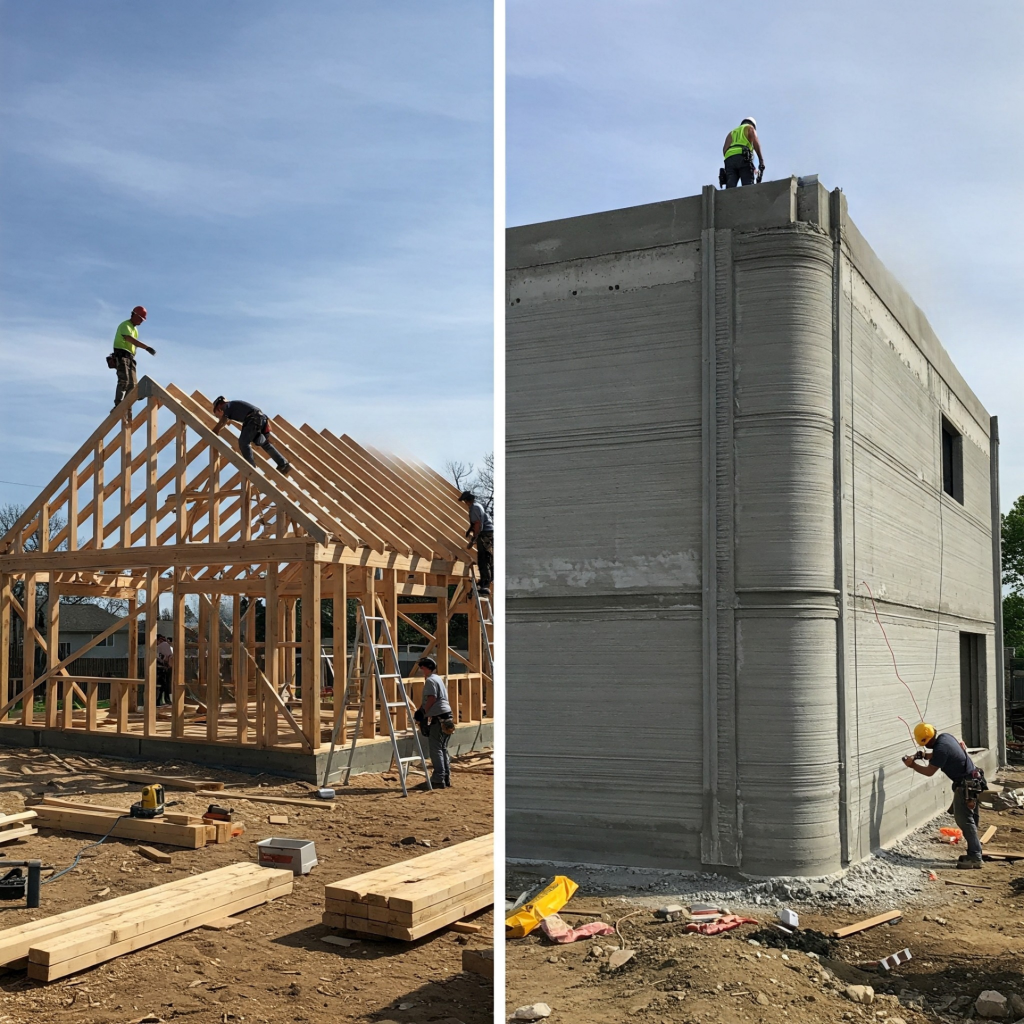The Australian dream of home ownership is facing unprecedented challenges, with soaring material costs and labor shortages making traditional construction increasingly expensive and time-consuming. But what if there was a revolutionary technology that could build homes faster, more affordably, and with less labour? Enter 3D printing – a game-changing approach poised to transform the construction industry, offering a beacon of hope for aspiring homeowners and a powerful solution for social housing needs.
For generations, timber-framed houses have been the standard in Australia. However, the cost per square metre for traditional builds is on the rise, heavily influenced by fluctuating timber prices and the intensive labour required. 3D printing technology offers a compelling alternative, promising significant savings in both these areas.
The Cost Advantage: Printing Your Way to a More Affordable Home
One of the most significant benefits of 3D printing homes lies in its potential for drastic cost reduction per m2. Traditional wood framing involves multiple stages: purchasing and transporting timber, measuring, cutting, and assembling frames, all of which are labour-intensive and generate material waste.
In contrast, 3D home printing utilises materials like specialised concrete or mortar, which can often be sourced locally and applied with remarkable precision. Large-scale 3D printers, guided by digital blueprints, extrude the construction material layer by layer to create the structural walls of a house. This process minimises waste, as the exact amount of material needed is calculated and used – a stark contrast to the offcuts and surplus common in timber framing.
Industry reports and early projects indicate that the wall construction phase, a major component of building costs, can be up to 50-70% cheaper with 3D printing compared to conventional methods. While the overall cost saving for a completed home will vary depending on finishes and other factors, the reduction in foundational and structural expenses is substantial. This makes the dream of owning a home, or even a more spacious one, more attainable.
Less Labour, More Efficiency: Tackling the Skills Shortage
Australia’s construction industry is currently grappling with a significant skilled labour shortage. This not only drives up wages, adding to the overall cost of traditional builds, but also leads to project delays. 3D printing technology directly addresses this challenge by automating a significant portion of the construction process.
A 3D printer can operate for extended periods with minimal human oversight, guided by a few skilled technicians. This dramatically reduces the number of on-site labourers required for the structural build. While skilled tradespeople like electricians, plumbers, and finishers are still essential, the demand for manual framers and bricklayers can be significantly lessened. This not only cuts down on direct labour costs but also reduces associated expenses like site management and insurance. The result is a more streamlined and efficient building process, less susceptible to labour availability issues.
Speed of Construction: From Foundation to Frame in Days, Not Weeks
Time is money in the construction world. Traditional wood-framed homes can take months to reach the lock-up stage, with weather conditions and material delivery often causing unforeseen delays. 3D printing offers a remarkable acceleration of this timeline.
The actual printing of a home’s walls can often be completed in a matter of days, or even hours, depending on the size and complexity of the design. Imagine the structural framework of a home appearing on-site in under 48 hours – this is the reality that 3D printing brings. This rapid construction not only means homeowners can move in sooner but also reduces holding costs for developers and allows for a quicker turnaround on housing projects.
A Game-Changer for Housing Commissions and Council Integration
The cost and speed advantages of 3D-printed homes present an unparalleled opportunity for addressing Australia’s social and affordable housing crisis. Housing commissions and local councils are constantly seeking innovative solutions to provide safe, dignified, and affordable living spaces for vulnerable populations.
3D printing can enable the rapid development of high-quality social housing at a fraction of the traditional cost and time. This means more homes can be built with existing budgets, helping to alleviate long waiting lists. Furthermore, the design flexibility of 3D printing allows for the creation of diverse and aesthetically pleasing housing that can be tailored to specific community needs and seamlessly integrated into existing neighbourhoods.
Councils across Australia should be proactively exploring and integrating 3D printing technology into their housing strategies. Initiatives like allocating land for pilot projects, streamlining approval processes for 3D-printed constructions, and partnering with innovative construction tech companies can pave the way for a future where affordable housing is more readily available. Early adoption by local governments can also stimulate local innovation and job creation in this burgeoning sector. We’ve already seen pioneering examples, such as regional councils in New South Wales, trialling this technology for social housing, demonstrating its viability and potential.
The Future is Now: Embracing Innovation in Construction
While 3D home printing is still an emerging technology, its potential to revolutionise the construction industry is undeniable. The clear advantages in cost per m2, reduced labour requirements, and speed of construction make it an incredibly attractive proposition. From individual homebuyers seeking more affordable options to government bodies aiming to tackle housing shortages, 3D printing offers tangible solutions.
As the technology matures, materials become more sophisticated, and building codes adapt, we can expect to see an increasing number of 3D-printed homes dotting the Australian landscape. It’s a shift that promises not just cheaper and faster builds, but a more sustainable and accessible future for housing.
What are your thoughts on 3D-printed homes? Would you consider this technology for your next home or project? Share your comments below and let’s discuss the future of construction!
If you found this article insightful, please share it with your network!







